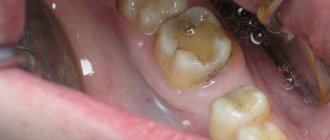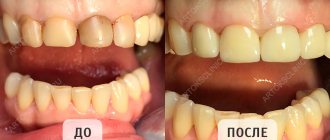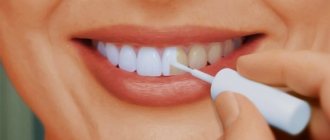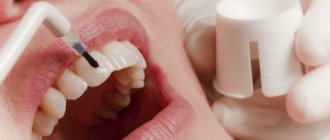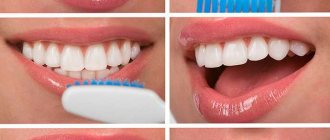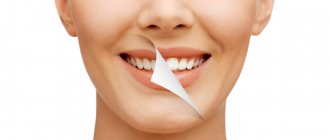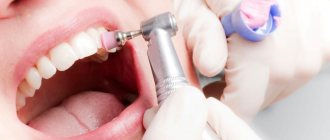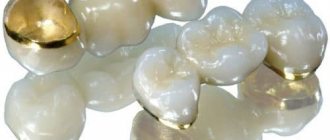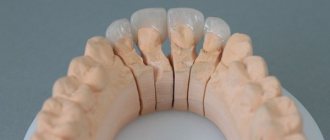Dental enamel implantation is a new and progressive direction in aesthetic dentistry. The essence of the procedure is to restore the enamel coating by fixing special orthopedic devices - veneers - to the front of the teeth. These are thin plates made of ceramics that are used to correct the color and shape of teeth.
In addition to the fact that the thickness of the coatings is only 0.3-0.6 mm, veneers are similar in elasticity and strength to natural enamel and act as an infallible tool for giving teeth exemplary evenness and aesthetics. Installing veneers helps eliminate curvatures, hide pigment spots, chips, cracks and a number of other defects that have appeared on the surface. Although ceramic plates do not provide a therapeutic effect, they improve the appearance of teeth and make a smile impeccable.
Causes of enamel destruction
There are quite a lot of factors that destroy enamel. The most common ones are:
- Poor oral and dental hygiene.
- The use of hygiene products containing aggressive substances that cause demineralization of enamel.
- Disruption of the digestive system.
- Abuse of sweet, sour foods, which chemically affect the top layer of enamel.
- Systematic consumption of energy drinks.
- Smoking. Tobacco contains nicotine, which destroys enamel.
- An incorrect bite causes the tooth enamel to wear away.
- Injury to teeth.
Teeth extension techniques
There are several modern methods of teeth extension. The doctor will select the most suitable one after examining the patient. The choice will depend, first of all, on the degree of damage to the teeth.
Tooth extension with a filling
Photopolymer materials allow you to correct a small chip, crack in the enamel or a stain on it. They:
- match the natural color of the teeth,
- do not harm healthy dental tissues and oral mucosa,
- allow you to accurately recreate the damaged area,
- allow you to preserve the natural layer of enamel and nerves.
The procedure is affordable and does not take much time: a filling made from a special quick-hardening composition is installed on the chipped tooth.
Veneers and Lumineers
The use of these thin ceramic onlays, which hide tooth imperfections, is an artistic restoration.
Veneers visually enlarge teeth. To install them, the patient will have to visit the dentist at least 2 times so that the doctor:
- Selected the type of lining.
- Under anesthesia, I ground off the enamel at the installation site.
- Installed veneers with dental cement.
Lumineers hide darkened enamel, chips and cracks, and mask large spaces between teeth. They are thinner and lighter than veneers, their installation does not require grinding down the enamel, and removal does not harm it.
Tooth extension with a crown
If the tooth is almost completely destroyed, previous restoration methods will be ineffective. In this case, the doctor installs a crown.
Extension on a pin
If the tooth is seriously damaged, it is built up onto a pin. Doctor:
- Refers the patient for an x-ray.
- A pin - a rod made of titanium or fiberglass - is implanted into the bone tissue of the tooth.
- Forms the visible, crown part of the tooth.
How much tooth extension costs will depend on the complexity of the case and the chosen technique.
Benefits of implantation
The main advantages include:
- The ability to restore tooth enamel at different degrees of destruction.
- Teeth regain their natural smoothness and shine.
- Strengthening dental health from exposure to external irritants.
- Prevention of the development of dental diseases, especially caries.
Indications for the use of enamel implantation:
- damage to the enamel, disrupting the aesthetics of the tooth;
- decrease in the level of minerals and salts in tooth enamel;
- development of pathology, accompanied by the appearance of spots on the enamel;
- expansion of interdental gaps;
- malocclusion.
Fixed prosthetics with veneers: installation features
Artificial enamel substitutes are a winning option for solving problems with increased abrasion and deterioration of the color of the natural enamel layer, abnormalities in the outline and location of teeth and other aesthetic defects.
The procedure is painless and occurs in several stages:
- preparation for prosthetics. If necessary, the doctor removes carious formations, renews previously installed fillings, and performs sanitation of the oral cavity;
- then impressions are taken from the jaw and sent to a dental laboratory for the production of plates;
- finished structures using durable dental glue are fixed to the surface of the teeth being restored.
After fixation, the doctor checks the correctness of the bite and evaluates the accuracy of the contact of the implanted units with the adjacent teeth and those located on the opposite jaw. If inconsistencies are identified, adjustments are made. At the end of the procedure, the doctor removes excess adhesive.
Enamel implantation does not cause pain and does not require the use of anesthetics, therefore it is suitable for patients with allergies to painkillers. In addition, a healing abutment is not required for enamel implantation.
Other ways to restore enamel
- Filling, which is prescribed in the complete absence of a layer of enamel. The filling material is applied in a thin layer to the tooth, and after hardening, the chewing element takes on a healthy appearance with smooth and shiny enamel.
- Fluoridation. This is the most famous and accessible method of restoring enamel, in which a substance containing fluoride is applied to the teeth. Fluoride comes in gel form. After fluoridation, teeth become smooth and shiny.
- Microprosthetics, when a veneer or lumineer is attached to damaged teeth. The procedure is effective, but expensive.
- Remineralization. A procedure in which calcium phosphate is applied to the teeth. Over time, the applied substance becomes durable and is able to protect teeth from external irritants. This method of restoring enamel is used only when it is partially destroyed. If there is a complete absence of enamel, the method is not effective.
At the first signs of tooth hypersensitivity, you should immediately contact a dentist, who can determine the cause of tooth hypersensitivity. After diagnosis, the doctor will prescribe a course of treatment.
Cosmetic enamel restorations: natural biomimetic layering technique
There is no doubt that the human face is one of the components of the overall profile of external attractiveness. If we group the elements of the face by importance, the mouth, of course, occupies one of the first places: it forms both the overall facial expression and helps to display feelings of friendliness, agreement or gratitude. A smile, in turn, expresses a feeling of happiness and pleasure, but even with other emotions it has an extremely important facial meaning. In turn, a smile consists of the profile of the face, the profile of the gums, teeth and the emotion that it expresses. Therefore, to correct a smile, it is necessary to achieve harmony of these four components, also taking into account the specifics of their individuality. Lips are a kind of frame for a smile, and teeth and gums represent a picture placed in this frame. A healthy and harmonious smile has a positive impact on the development of feelings of trust and confidence in a person. Even minor defects in one of the components of a smile, such as a violation of the contour or color of the front teeth, compromise the overall aesthetic condition of a person’s face.
This article will discuss the role of hard tissue, especially enamel, in shaping the aesthetic appearance of the smile, and will present a new minimally invasive technique for creating a more youthful smile profile in compromised clinical situations with minimal biological loss.
The role of tooth enamel
Enamel is one of the most important structures of the tooth, both from a functional and aesthetic point of view. Essentially, enamel is a uniquely organized nanostructured material that forms the outer covering of teeth. It consists of crystalline calcium phosphate, which makes up 96% of the structure, with the remaining 4% being organic components and water. The organic component of enamel is a breakdown product of the main protein - amelogenin. Mature enamel does not contain cells and does not regenerate, unlike other biomineralized tissues such as bone and dentin.
Loss of enamel surface leads to deterioration of the aesthetic parameters of the smile
Enamel, covering the outer coronal surface of the tooth, must withstand a significant number of acting factors in conditions of constant demineralization and remineralization processes. In such a situation, the loss of a certain layer of the tooth surface is simply inevitable. However, this process is normal during the aging of the body, in addition to which it can also be pathological. The latter differs from the physiological one in that it is accelerated by the action of endogenous and exogenous factors.
Depending on the cause, there are four different types of tooth wear: attrition, abrasion, erosion and abfraction. Each of these processes, in addition to dysfunction and aesthetic parameters of the smile, also affects the general state of health.
Attrition (Figure 1) is the loss of dental tissue resulting from mechanical action between the surfaces of opposing teeth during mastication and parafunctional activity. This process is most often noticeable on the occlusal surfaces of the posterior teeth and the cutting edges of the anterior teeth.
Photo 1: Attricia.
Abrasion (photo 2) refers to mechanical abrasion of teeth, provoked by reasons different from those during the interaction of antagonist teeth. Most often, this process develops when certain exogenous agents are present between the teeth, such as an overly abrasive toothbrush or paste, or during a certain method of brushing teeth.
Photo 2: Abrasia.
Erosion (photo 3a and b) is the pathological wear of teeth caused by the action of chemicals, most often acids of internal or external origin. The rate of erosion progression is also influenced by the quality of saliva (rate of salivation, pH and saliva components).
Photo 3a,b: Erosion.
Abfraction (photo 4) is a pathological process of loss of a layer of the surface of the teeth, which occurs when teeth are repeatedly compressed and bent under the influence of occlusal loads, resulting in the destruction of enamel rods. This process is most noticeable in the area of the tooth neck.
Photo 4: Abfraction.
In addition to these four reasons, the loss of hard tooth tissue can be provoked by developmental anomalies (photo 5a-c), especially amelogenesis imperfecta and dentinogenesis, which are predisposing factors for progressive pathological abrasion.
Photo 5a-c: Teeth with developmental defects: enamel hypoplasia (a), amelogenesis imperfecta (b), dental fluorosis (c).
The relationship between the processes is quite logical: with inadequate enamelogenesis, the tissue is very thin and soft, therefore, it wears out more easily, while with imperfect dentinogenesis, the strength of the bond between dentin and enamel is impaired, which leads to easy separation of these tissues at the interface. The loss of hard dental tissues changes their morphological shape, leads to the development of various types of sensitivity, pulpal complications, discoloration of teeth, loss of vertical parameters of occlusion and associated occlusal disorders. The latter, accordingly, provoke changes in neuromuscular function, chewing efficiency and smile aesthetics due to an imbalance in the horizontal component of the occlusal plane. Loss of the canine route of insertion increases the load on the posterior group of teeth, which consequently causes progressive wear of the molars and an increased risk of chipping of restorations in this area. An unstable state of occlusion, among other things, also provokes biting of the cheeks and tongue during chewing.
Optical characteristics of anterior teeth
As mentioned earlier, teeth undergo changes over the years that directly affect their appearance and color. Due to an increase in the thickness of dentin and a decrease in the thickness of enamel, the parameters of transparency and opacity of teeth also change, which can be explained by the difference in interaction with light when the composition and level of mineralization of hard tissues are disrupted. Enamel transmits up to 70.1% of the light flux, while no more than 52.6% passes through dentin. Thus, it is clear why dentin is the main light former, and enamel is only a modifier.
Optical properties of natural enamel
When working with enamel, you need to understand the specific orientation of enamel prisms in the thickness of the fabric. As a rule, they are located at an angle of 90 degrees relative to the dentin surface. In the cervical region, the prisms depart from their usual horizontal orientation and tilt apically. In the area of the cutting edge, the prisms have an oblique direction, and in the area of the edges they are almost in a vertical position. Due to this change in the orientation of the prisms, the transparency of the enamel also decreases. Enamel also changes the chromatic parameters of teeth due to processes such as reflection, transmission and refraction of light, as well as based on the characteristics of thickness and surface texture. In addition, enamel has the ability to weaken the colors of the lower range, which also affects the chromatic parameters of the tooth. The light reflectance or transmission properties of enamel depend on its texture, the orientation of the enamel prisms and the ability to refract light depending on histological characteristics. Enamel translucency may also be associated with variations in calcification levels, as more porous and less mineralized enamel has higher levels of light dispersion.
Optical properties of dentin
Dentin can be considered as dental tissue that largely determines the overall shade of the tooth. From an optical point of view, dentin is a structure with low transparency and varying parameters of intensity and color saturation. Dentin is relatively opaque because the arrangement of the dentinal tubules allows dentin to exhibit selective diffraction of light, causing some rays to be reflected while others are absorbed. During the development of the organism, primary dentin is replaced by secondary and tertiary dentin, which are characterized by a different structure and composition, and, consequently, other optical characteristics. In elderly patients, a decrease in the diameter of the dentinal tubules causes progressive dentin sclerosis and high color saturation of this structure.
Basic characteristics of teeth
The visual characteristics of teeth change with age and can be categorized into four age groups: childhood, adolescence, middle age and old age.
In childhood (photo 6a-c)
Photo 6a-c: View of teeth in childhood.
Around the age of 10 years, the enamel is characterized by an almost milky white hue, the surface layers are at their most opaque and often look as if they have been frostbitten. In this case, the enamel, as a rule, demonstrates a clear opalescent effect, and its surface with micro- and macrostructure has a very low surface gloss; The cutting edges of the teeth are completely covered with enamel.
In adolescence (photo 7a-c)
Photo 7a-c: View of teeth in adolescence.
Around the age of 20, the enamel becomes less white, and its transparency increases due to the abrasion of the upper layers of the young, opaque enamel. The enamel surface is still microstructured and has a low gloss level. The dentinal areas, although still covered with enamel, become slightly noticeable with a blue and orange tint.
Middle age period (photo 8a-c)
Photo 8a-c: View of teeth in middle age.
During this period, the micro- and macrostructure of the enamel surface decreases, and its surface gloss increases. The enamel becomes more transparent, and dentin shades become more pronounced.
Elderly period (photo 9a-c)
Photo 9a-c: View of teeth in older age.
The enamel is characterized by increased transparency, the shades become closer to bluish and grayish, the microstructure of the enamel is almost absent, and the macrostructure is significantly reduced. Also, at the same time, the parameters of surface gloss increase, dentin looks darker and even less transparent compared to teeth in middle age.
Restoration strategy
Understanding all the specifics of light changes and optical characteristics of enamel, which vary with age, the doctor can ensure that the most artistic and natural restoration effect is obtained. The restoration strategy includes not only the process of modeling the lost layers of tissue, but also the optimal approach to material selection, processing, texturing and polishing. Cosmetic enamel restorations can be successfully used to correct minor violations of the structure of teeth, their brightness and contour parameters. The loss of the surface layer of enamel provokes disturbances in the visual perception of the front teeth, their brightness parameters, contour and the overall aesthetic profile of the smile. Because the enamel layer is quite thin, its loss is often associated with the loss or at least exposure of a certain amount of dentin tissue. Therefore, restoring the natural appearance of enamel requires a careful analysis of the need for restoration and lost dentin tissue, which also affects the parameters of depth, color and type of restoration.
Selection of restorative materials based on optical properties
Although dentin determines the basic color of the tooth and its shade, this parameter is perceived by the observer as somewhat altered due to its modification by enamel tissues depending on its thickness, texture and level of polishing. Enamel does not actually change the shade (color) of the tooth, but only gives it more or less saturation depending on its thickness. Placing a layer of enamel of the required thickness over the dentin area increases or decreases the brightness parameters of the tooth, determining the so-called “liveness” of the restoration. When simultaneously restoring both enamel and dentin tissues, it is necessary to take into account the difference in color transmission by these structures: therefore, more opaque composites must be used for the dentin portion of the restoration, and more transparent shades must be used for the enamel. Considering that a huge amount of restoration materials with different shades of color and transparency parameters are produced all over the world, a systematization of these materials depending on their optical characteristics was proposed (Table 1).
Table 1: Material category.
| Material category | Target | Example |
| Opaque group | To mask discolorations | Beautyfil Opaquer |
| Dentin group | ||
| Opaque dentin | To replace deep dentin layers | Beautifil II A20 (Opaque dentin) |
| Normal dentin | To replace the outer layers of dentin | Beautifil II A2 (universal dentin) |
| Enamel group | ||
| Transparent | For enamel replacement | Beautifil II Enamel HVT |
| Effect group (dyes) | To create specific effects | Beautyfil II Gum shade |
Smile style and surface texture design
The technique of natural-mimetic restorations is consistent with the general psychology of the patient’s perception, as described in the Smile Wheel concept. The design of the smile and the texture of the surface of the teeth should be chosen in accordance with the specific perception of the patient, his individual wishes and vision of treatment results. However, this approach requires a deep understanding of the patient’s personality in order to adequately interpret his subjective aspects. To analyze human personality, the author of the article uses the “DISC” principle, developed by William Moulton Marston, and presented by him in his publication “The Emotions of Normal People” in 1928. Marston proposed that people are motivated by four internal drives that drive his personality images. To describe the processes, he used four behavioral tendencies, which he defined by four letters of the alphabet: D-domination (dominance), I-influence (influence), S-steadiness (stability) and C-compliance (compliance).
D-Smile Style
I-Smile Style
S-Smile Style
C-Smile Style
Based on DISC personality traits, the author classifies smiles into four categories according to Tables 2 and 3.
Table 2: DISCover smile design - dental characteristics.
| Smile design | Central incisors | Tops of fangs | Lateral incisors | IAL (esthetic cutting edge line) | Angle IAL | Tooth axis |
| Smile Design D | Lack of dominance with a square shape | Flat type | Flat and can touch the esthetic incisal line (IAL) | Direct or R = reverse | 90° and more | Straight or slightly deviated |
| Smile Design I | Dominant type with rectangular shape | Rounded flat | Rounded and flat cutting edges that do not touch the aesthetic cutting edge line (IAL) | Descending to direct type | 85-90° | Straight |
| Smile Design | Dominant type with oval shape | Rounded | Delicate, rounded mesial and distal incisal edges that do not touch the esthetic incisal line (IAL) | Descending type | 75-85° | Slightly convertible |
| Smile Design C | Dominant type with triangular shape | Spot | Rounded distal and flat mesial cutting edges that touch the IAL | Descending type | 70-80 ° | Convertible |
Table 3: DISCover smile design: personality characteristics.
| Smile design | Personality characteristics | Suitable for |
| Smile Design D | Goal-oriented, competitive, direct, extroverted, driven by desire, ambitious, strong willed: “Just do it.” | Entrepreneurs, salespeople, legal or judicial professions, managers and related professions |
| Smile Design I | Human and personality oriented, talkative, spontaneous, enthusiastic, persuasive personality type: “Have fun.” | Marketing, public relations, training, tourism, retail and related professions |
| Smile Design | Stable, reliable, conservative, loyal, relaxed, passive, patient type: “Do everything together.” | Training, Education, Finance, Economics, Human Resources, Help Desk, Customer Service, Manufacturing, etc. |
| Smile Design C | Cautious, detail-oriented, logical, organized, diplomatic, "do it right" type. | Accounting, auditing, engineering, medicine, research and development, agriculture, computer programming, etc. |
To achieve optimal restoration parameters, the doctor should always take into account age-related variations in the enamel surface. With age, patients experience a thinning of the covering structure of the tooth, but its modeling should still be carried out taking into account the individual wishes of the patient.
The surface texture of a tooth is determined by three factors:
- Surface texture or degree of surface smoothness/roughness. This parameter can be divided into two categories.
- Macrotexture (vertical and/or horizontal projections and depressions, ridges and grooves visible on the surface of the tooth) and microtexture (small surface irregularities associated with the approximation and calcification of the enamel matrix during tooth formation, depressions, vertical lines and perikymata).
- The gloss or degree of shine of a tooth, also known as simply shine (photos 10 and 11). Luster determines the amount of light reflected on the surface of the crown. This parameter is no less important than the color and contour of the future restoration. It should be noted that shine is not related to age and is genetically or congenitally determined.
Photo 10: Macrotexture with low gloss value.
Photo 11: Microtexture with high gloss value.
Naturo-mimetic layering technique (restoration) (NLT)
Given the complex structure of natural teeth, it is quite difficult to replicate it by simulating the parameters of enamel and dentin. When implementing an NLT protocol, it is important to conduct a detailed analysis of the color, opacity, translucency, texture, surface gloss and special characteristics of teeth to be restored in the future. During NLT restoration, the desired result is achieved by applying the correct thickness of transparent or translucent enamel group materials over a saturated and opaque dentin replacement composite. There are various clinical situations in which it is necessary to achieve the effect of enamel rejuvenation, treatment for which is carried out differently depending on the type of tooth defect and the patient’s wishes regarding restoration. Depending on the clinical situation, the clinician should choose one of the above NLT methods. The natural mimetic layering technique is based on a new classification of shade layers and is divided into the following clinical algorithms.
NLT monolayer
With this technique, the defect is restored with one layer of composite. Typically, opaque shades or materials designed to simulate optical effects are not used in such situations. However, in any case, it is necessary to take into account the parameters of the required restoration layer. The higher color of the area and its opacity justifies the use of a thicker layer. On the other hand, using an enamel shade that is too transparent can cause a gray effect in the restoration, which can again be corrected by the thickness of the layer of material used. At the same time, by increasing the thickness of the dentin material layer, we simultaneously influence the parameters of shade and color intensity, and, therefore, we need to look for a suitable compromise for maximum imitation of natural tooth tissue (photo 13).
Photo 12: NLT monolayer technique.
Photo 13: NLT two-layer technique.
NLT three-layer technique
This technique is used for teeth that require significant color modification, such as when restoring non-vital teeth. The method involves the application of opaque materials, which do not need to be covered with composites intended to form optical effects. As a rule, the opaque group of materials with a three-layer technique is covered with dentin and enamel shades, imitating natural tooth tissue (photo 14).
Photo 14: NLT three-layer technique.
NLT-comprehensive layering technique
Any restoration that requires the use of a group of materials designed to create optical effects is complex. And it doesn’t matter whether it is made only with such materials, or in combination with opaque analogues, or enamel-dentin-substituting composites. Therefore, the technique can be called mono-complex, two-complex or tri-complex. The use of a composite to create a specific effect (to create opalescence, orange or yellow tints, stains, enamel cracks, white spots, etc.) must be justified by the results of careful color analysis and mapping of the tooth surface. This type of restoration is mainly used in the incisal area of the tooth, where the range of translucency and opalescence increases significantly (photo 15-17).
Photo 15: NLT monocomplex technique.
Photo 16: NLT-two-complex technique.
Photo 17: NLT - three-complex technique.
The level of polishing (smoothness) of the surface changes the indicators of chromatic perception, and this parameter is inversely proportional to the lightness of the restoration. The more a surface is polished, the greater its light transmission becomes and, consequently, the brightness decreases. In turn, the absence of polishing (matte finish or the presence of a more pronounced microstructure) leads to a more reflective surface and a brighter restoration.
Photo 18: Naturo-mimetic layering technique (NLT): step-by-step algorithm.
Conclusion
Cosmetic dentistry is one of the fastest-growing branches of dentistry, advancing in tandem with greater awareness and improved patient well-being. After all, everyone wants to have a beautiful, stylish and healthy smile. An aesthetic smile today is the main criterion for patients, indicating that their treatment was successful and in accordance with their own wishes.
Author: Dr Sushil Koirala, Nepal
Stages of treatment
How much time and visits it takes to restore a broken tooth and how the manipulation proceeds depends on the defect, location, degree of destruction and restoration technology.
- Direct restoration
Restoration of enamel and artistic extension with composites takes 1 visit
. Their cost is low.
When restoring enamel with a composite, the dentist simply applies the paste, smoothes it and strengthens it with light. Then the teeth are polished. The chipped tooth is restored by simulating the chipped piece. Then turn on the lamp. Finally, the tooth is ground.
- Indirect restoration
Requires at least 2 visits
. During the first one, the teeth are prepared, an impression is taken, and, if necessary, a photograph is taken. Then inlays, pins or veneers are installed. Severely damaged teeth require more work, especially if crowns are needed.
Reviews
Feedback from all patients, without exception, about remineralization therapy carried out in the dental office is positive - tooth sensitivity noticeably decreases after the first procedure. The effect of enamel remineralization at home may be less pronounced if the patient does not follow the rules for its implementation.
Reviews about the use of varnishes and enamels for teeth that have a whitening effect at home are not so clear. Many consumers who have used these products on their own report a negative result - the drug is difficult to distribute evenly over the entire surface of the teeth.
Only a dentist can guarantee the high efficiency and safety of covering teeth with artificial enamel. When performing this procedure in a medical institution, not only the algorithm of necessary actions is followed, but all possible risks for the patient are taken into account.
Features of the procedure in dentistry
In dental offices, fluoride-containing preparations are applied to the surface of teeth in two ways:
- brush or spatula-shaped stick;
- using special trays made individually for each patient based on impressions of his dentition.
Before applying the drug, the dentist cleans the surface of the enamel from soft plaque, slightly dries it with a stream of air and, using gauze swabs, isolates the teeth from saliva.
Features of the use of fluoride composition depend on its type and are determined by the manufacturer. The number of procedures required to achieve a therapeutic effect is prescribed by the attending physician.
What is tooth enamel?
Tooth enamel is considered the hardest, strongest and most durable tissue in the human body. This is the outer protective shell that covers the teeth. It contains about 97% mineral salts. It performs important functions:
- takes on the greatest load when chewing food;
- prevents the destructive influence of negative external factors;
- provides aesthetic appeal.
Interestingly, this is a unique organ of its kind that is not capable of recovery. Therefore, teeth need to be protected and taken care of in a timely manner.
Is it possible to restore tooth enamel?
Many people are interested in whether tooth enamel is restored. This tissue cannot grow or repair itself. But modern methods can strengthen it, fill microscopic cracks and chips.
It is best to take care in advance to prevent tooth decay. Here are some simple recommendations:
- Rinse your mouth thoroughly after breakfast, lunch, dinner, snacks and brush your teeth twice a day.
- Minimize the amount of simple carbohydrates in the diet, increase the consumption of solid foods - apples, cabbage, carrots.
- Give preference to brushes of medium hardness.
- Use whitening pastes only when absolutely necessary.
- In case of bruxism, it is best to use mouth guards at night to prevent damage to the teeth while you sleep.
If it was not possible to prevent the problem, microcracks, stains appeared, or even the enamel on the tooth broke off, you need to urgently consult a doctor to stop the progression of the process.
Innovative method
Dental enamel implantation is restoration at the molecular level. The procedure is currently considered the most effective and high-quality.
The technique consists of applying a special agent (an analogue of the protein amelogenin), which is part of the protective layer, to the surface of the problem unit.
During the process of damage, this substance is lost, so during implantation it is artificially supplied. After the procedure, the tooth returns to its former shape and even becomes more attractive. The implanted tissue does not differ in color from the natural one.
On a note! Recovery continues for about a month after the procedure, but the tissue is able to fully perform all the functions of tooth enamel immediately.
This result is achieved due to the formation of a crystal lattice after the protein enters the pores.
Indications for implantation will be the following conditions:
- darkening of the tooth (when other methods do not work);
- fluorosis;
- mechanical damage;
- pathological bite (mild severity);
- irregular crown shape;
- large interdental spaces.
On a note! The procedure is a minimally invasive method and therefore does not require pain relief, which significantly narrows the list of contraindications.
The video shows the process of dental enamel implantation.
Advantages and disadvantages
Experts attribute the following factors to the advantages of the technique:
- high aesthetics;
- elimination of cosmetic defects of any complexity;
- possibility of bite correction;
- return of soft tissue protection;
- painlessness;
- durability, restoration can last until the end of life.
The only disadvantage of implantation will be its high cost, compared to other restoration options. This is an innovative method of recovery, and it has no categorical contraindications or significant disadvantages.
Causes of development of tooth enamel erosion and methods of treating pathology.
Come here if you are interested in how dangerous cracks in tooth enamel are.
At this address https://www.vash-dentist.ru/protezirovanie/nesemnyie-p/stiranie-zubov.html we will talk about the treatment of pathological tooth abrasion.
How much does the drug cost at the pharmacy?
Fluoride varnishes, which can be used at home, can be purchased in stores and pharmacies specializing in the sale of dental materials.
The price of these products depends on their composition and manufacturer:
- Fluoride varnish (25 g bottle) – 230-250 rubles;
- Dental Paint varnish (10 ml bottle) – from 2000 rubles;
- White Enamel enamel (6 ml bottle) – from RUB 2,300;
- Color Professional enamel (pack of 6 ml) – from 2000 rubles;
- Celebrity white flash polish (pen bottle 3 ml) – 500 rub.
All of the above products, except for the drug "Fluorovarnish", allow you to temporarily whiten the surface of your teeth.
The cosmetic effect lasts for 12-24 hours and disappears when drinking carbonated drinks, solid foods, or after brushing your teeth.
Price issue
| Method | Price (in rubles) |
| Fluoridation | Glubokoe - from 1200 Simple 1 tooth - from 300 |
| Remineralization | 1 jaw – from 1500 |
| Restoration with filling material | From 1000 |
| Veneers | From 10000 |
| Lumineers | From 25000 |
| Implantation | From 10000 |
Comments
Please tell me how enamel implantation differs from procedures such as remineralization or fluoridation?
Alena (03/08/2020 at 02:25) Reply to comment
- Dear Alena! Remineralization and fluoridation are more aimed at strengthening the protective properties of the enamel so that it can resist carious bacteria. As for enamel implantation, as the creator of this technique assures, it promotes tissue regeneration, after which their healthy color, shine and structure are restored.
Editorial staff of the portal UltraSmile.ru (03/15/2020 at 09:07) Reply to comment
Are there other drugs for enamel implantation besides innoDent? Are they used in Russia? What is the difference? In which countries does enamel implantation have a long history?
Anna (05/23/2021 at 01:06 pm) Reply to comment
Write your comment Cancel reply
Alternatives
There are clinical cases when it is impossible to restore a tooth. If half of the tooth or the entire crown part is destroyed, a crown is already needed. The root is damaged - you have to choose between:
- Implantation
A metal pin – an implant – is screwed into place of the removed root. A crown is put on it. Neighboring teeth are not involved. The implant performs the functions of a natural root. It comes with a lifetime warranty
.
- Bridge prosthesis
The artificial tooth is located between two crowns. Load-bearing teeth are ground down for crowns. Does not prevent bone loss. Should be changed every 5-7 years
.
